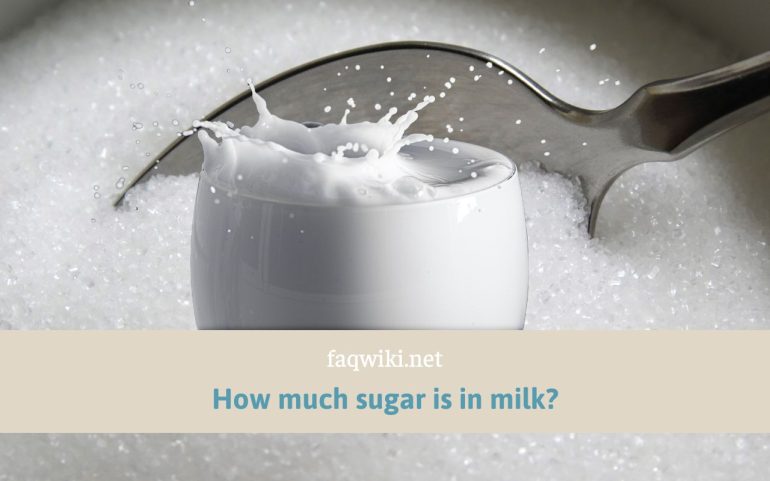How much sugar is in milk?

Milk is a staple food in many households worldwide. It is rich in essential nutrients, including protein, calcium, and vitamins. However, some people are concerned about the sugar content of milk. In this article, we will examine how much sugar is in milk, understand the health implications of sugar in milk, and discuss strategies for reducing sugar intake from milk.
Milk and Sugar Content
The sugar content of milk varies depending on the type of milk. Whole milk contains natural sugar in the form of lactose, which accounts for about 12 grams of sugar per cup. Skim milk and low-fat milk also contain lactose, but the sugar content is lower, with about 9 grams of sugar per cup. Flavored milk, such as chocolate milk, contains added sugar, and the sugar content can range from 12 to 20 grams of sugar per cup. Plant-based milk alternatives, such as soy milk and almond milk, may contain added sugar or sweeteners.
Understanding Sugar in Milk
Natural sugar in milk is lactose, which is a type of carbohydrate. Lactose is a disaccharide composed of glucose and galactose. It is broken down by the enzyme lactase in the small intestine and absorbed into the bloodstream. Flavored milk contains added sugar, which can come in the form of sucrose, high fructose corn syrup, or other sweeteners. Plant-based milk alternatives may also contain added sugar or sweeteners such as stevia or monk fruit extract.
Health Implications of Sugar in Milk
Excessive sugar consumption is linked to several health problems, including obesity, type 2 diabetes, and tooth decay. The World Health Organization recommends limiting sugar intake to less than 10% of daily caloric intake, which is about 50 grams of sugar per day for an adult. The sugar content of milk is generally low compared to other sugary beverages, but flavored milk can contain significant amounts of added sugar. Therefore, it is important to consider the sugar content of milk when planning a healthy diet.
Controversies Surrounding Sugar in Milk
Some people argue that milk is not essential in a healthy diet and that the sugar content of milk makes it unhealthy. Others believe that milk is an important source of essential nutrients and that the sugar content is not a significant concern. The debate over the healthfulness of milk and its sugar content continues. However, most health experts agree that milk is a valuable source of nutrients and that the sugar content of milk is generally not a significant health concern unless consumed in excessive amounts.
Reducing Sugar in Milk
If you are concerned about the sugar content of milk, there are several strategies you can use to reduce your sugar intake from milk. Choosing low-fat or skim milk can reduce the sugar content of milk. Avoiding flavored milk or making your own flavored milk with less sugar can also reduce sugar intake. Choosing plant-based milk alternatives with no added sugar or sweeteners is another option.
Sugar in Milk and Special Populations
Children and people with diabetes may need to be especially mindful of their sugar intake from milk. Children often consume flavored milk, which can contain significant amounts of added sugar. People with diabetes may need to monitor their carbohydrate intake, which includes the sugar content of milk. Lactose-free milk is a good option for people with lactose intolerance, but it may contain added sugar or sweeteners.
Labeling and Regulation of Sugar in Milk
The government regulates the labeling of milk in terms of sugar content. Milk labeling laws and guidelines require that the sugar content of milk be listed on the nutrition label. Understanding milk nutrition labels can help consumers make informed choices about the sugar content of milk.
Conclusion
In conclusion, milk is a valuable source of essential nutrients, including protein, calcium, and vitamins. The sugar content of milk varies depending on the type of milk, with natural sugar in the form of lactose being the primary source. Flavored milk contains added sugar, which can significantly increase the sugar content. Plant-based milk alternatives may also contain added sugar or sweeteners. While excessive sugar consumption can lead to health problems, the sugar content of milk is generally not a significant concern unless consumed in excessive amounts.
Reducing sugar intake from milk can be achieved by choosing low-fat or skim milk, avoiding flavored milk or making your own with less sugar, or choosing plant-based milk alternatives with no added sugar or sweeteners. Children and people with diabetes may need to be especially mindful of their sugar intake from milk. Understanding milk nutrition labels can help consumers make informed choices about the sugar content of milk.
FAQs:
Is milk a healthy drink?
- Milk is a healthy drink that is rich in essential nutrients, including protein, calcium, and vitamins.
How much sugar is in milk?
- The sugar content of milk varies depending on the type of milk. Natural sugar in the form of lactose is the primary source of sugar in milk, with about 12 grams of sugar per cup in whole milk and 9 grams of sugar per cup in low-fat or skim milk. Flavored milk contains added sugar, which can significantly increase the sugar content.
How can I reduce sugar intake from milk?
- You can reduce sugar intake from milk by choosing low-fat or skim milk, avoiding flavored milk or making your own with less sugar, or choosing plant-based milk alternatives with no added sugar or sweeteners.
Is milk with added sugar unhealthy?
- Milk with added sugar can be unhealthy if consumed in excessive amounts. However, the sugar content of milk is generally not a significant concern unless consumed in excessive amounts.
